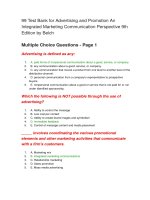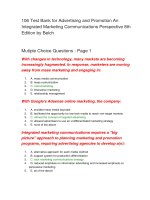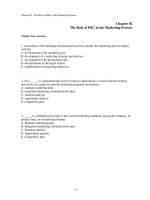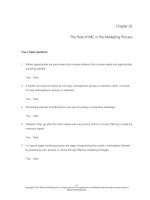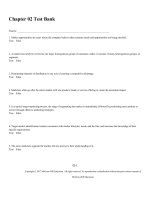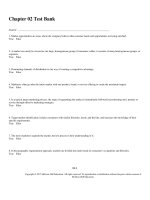Lecture Advertising and promotion: An integrated marketing communications perspective (10/e): Chapter 10 - George E. Belch, Michael A. Belch
Bạn đang xem bản rút gọn của tài liệu. Xem và tải ngay bản đầy đủ của tài liệu tại đây (981.95 KB, 19 trang )
Chapter 10
Media
Planning and
Strategy
Copyright © 2015 McGraw-Hill Education. All rights reserved. No reproduction or distribution without the prior written consent of
McGraw-Hill Education.
Media Plan
Guides media selection
Aims to find a combination of media to
communicate a message:
In the most effective manner
To the largest number of potential customers
At the lowest cost
Copyright © 2015 McGraw-Hill Education. All rights reserved. No reproduction or distribution without the prior written consent of
McGraw-Hill Education.
Activities Involved in Developing the
Media Plan
Situation
Situation
analysis
analysis
Marketing
Marketing
strategy
strategy plan
plan
Creative
Creative
strategy
strategy plan
plan
Setting
Setting media
media objectives
objectives
Determining
Determining media
media strategy
strategy
Selecting
Selecting broad
broad media
media classes
classes
Selecting
Selecting media
media within
within class
class
Media
Media use
use decisions
decisions
—
— broadcast
broadcast
Media
Media use
use
decisions
decisions
—
Media
Media use
use decisions
decisions
—
— other
other media
media
Copyright © 2015 McGraw-Hill Education. All rights reserved. No reproduction or distribution without the prior written consent of
McGraw-Hill Education.
Problems in Media Planning
Insufficient information
Sweeps periods: Used for measuring TV audiences
and setting advertising rates
Inconsistent terminologies
Time pressures
Difficulty measuring effectiveness
Copyright © 2015 McGraw-Hill Education. All rights reserved. No reproduction or distribution without the prior written consent of
McGraw-Hill Education.
Figure 10.4 Developing the Media Plan
Copyright © 2015 McGraw-Hill Education. All rights reserved. No reproduction or distribution without the prior written consent of
McGraw-Hill Education.
Using Indexes to Determine Where to
Promote
Survey of buying power index
• Charts the potential of a particular metro area, county, or
city relative to the United States as a whole
• Gives media planners insight into the relative value of a
market
Brand development index (BDI)
• Factors the rate of product usage by geographic area into
the decision process
Category development index (CDI)
• Provides information on the potential for development of
the total product category and not specific brands
Copyright © 2015 McGraw-Hill Education. All rights reserved. No reproduction or distribution without the prior written consent of
McGraw-Hill Education.
Figure 10.10 Using CDI and BDI to
Determine Market Potential
Copyright © 2015 McGraw-Hill Education. All rights reserved. No reproduction or distribution without the prior written consent of
McGraw-Hill Education.
Figure 10.11 Using BDI and CDI Indexes
Copyright © 2015 McGraw-Hill Education. All rights reserved. No reproduction or distribution without the prior written consent of
McGraw-Hill Education.
Figure 10.12 Criteria Considered in
the Development of Media Plans
Copyright © 2015 McGraw-Hill Education. All rights reserved. No reproduction or distribution without the prior written consent of
McGraw-Hill Education.
Figure 10.13 Marketing Coverage
Possibilities
Copyright © 2015 McGraw-Hill Education. All rights reserved. No reproduction or distribution without the prior written consent of
McGraw-Hill Education.
Figure 10.15 Three Methods of
Promotional Scheduling
Copyright © 2015 McGraw-Hill Education. All rights reserved. No reproduction or distribution without the prior written consent of
McGraw-Hill Education.
Figure 10.18 Representation of Reach
and Frequency
Copyright © 2015 McGraw-Hill Education. All rights reserved. No reproduction or distribution without the prior written consent of
McGraw-Hill Education.
Ratings Points
Program rating
• Measure of potential reach in the broadcast
industry
Gross ratings points (GRPs)
• GRP = Reach × Frequency
Target ratings points (TRPs)
• Number of people in the primary target audience
the media buy will reach, and the number of times
• Does not include waste coverage
Copyright © 2015 McGraw-Hill Education. All rights reserved. No reproduction or distribution without the prior written consent of
McGraw-Hill Education.
Figure 10.19 Estimates of Reach for
Network TRPs
Copyright © 2015 McGraw-Hill Education. All rights reserved. No reproduction or distribution without the prior written consent of
McGraw-Hill Education.
Figure 10.21 Graph of Effective Reach
Copyright © 2015 McGraw-Hill Education. All rights reserved. No reproduction or distribution without the prior written consent of
McGraw-Hill Education.
Factors Important in Determining
Frequency Levels
Marketing factors
Message Factors
Media Factors
• Brand history
• Message complexity
• Clutter
• Brand share
• Message uniqueness
• Editorial environment
• Brand loyalty
• New versus
• Attentiveness
• Purchase cycles
continuing
• Scheduling
• Usage cycle
campaigns
• Number of media
• Competitive share of
• Image versus product
sell
voice
• Target group
used
• Repeat exposures
• Message variation
• Wearout
•
Advertising
units
Copyright © 2015 McGraw-Hill Education. All rights
reserved. No reproduction
or distribution without the prior written consent of
McGraw-Hill Education.
Determining Relative Costs of Media
Cost per thousand (CPM)
Cost per ratings point (CPRP)
Daily inch rate
Copyright © 2015 McGraw-Hill Education. All rights reserved. No reproduction or distribution without the prior written consent of
McGraw-Hill Education.
Media Characteristics
Media
Advantages
Disadvantages
Television
• Mass coverage and high reach
• Impact of sight, sound, and
motion
• High prestige
• Low cost per exposure
• Attention getting
• Favorable image
•
•
•
•
•
Low selectivity
Short message life
High absolute cost
High production costs
Clutter
Radio
•
•
•
•
•
•
•
•
•
•
Audio only
Clutter
Low attention getting
Fleeting message
Local coverage
Low cost
High frequency
Flexible
Low production costs
Well-segmented audiences
Magazines
• Segmentation potential
• Long lead time for ad
• Quality reproduction
placement
• High information content
• Visual only
• Longevity
• Lack of flexibility
• Multiple readers
Copyright © 2015 McGraw-Hill Education. All rights reserved. No reproduction or distribution without the prior written consent of
McGraw-Hill Education.
Media Characteristics
Media
Advantages
Disadvantages
Newspapers
•
•
•
•
•
•
High coverage and low cost
Short lead time for placing ads
Ads can be placed in interest sections
Timely (current ads)
Reader controls exposure
Can be used for coupons
•
•
Short life and poor
reproduction quality
Clutter
Low attention-getting
capabilities
Selective exposure
Outdoor
•
•
•
Location specific
High repetition
Easily noticed
•
•
•
Short ads
Poor image
Local restrictions
Direct mail
•
•
•
•
High selectivity
Reader controls exposure
High information content
Enables repeat exposures
•
•
•
High cost/contact
Poor image (junk mail)
Clutter
Digital/
Interactive
•
•
•
•
•
User selects information
User attention
Interactive relationship
Direct selling potential
Flexible message platform
•
•
•
•
Privacy concerns
Potential for deception
Clutter
Lack of measurement
techniques
•
•
Copyright © 2015 McGraw-Hill Education. All rights reserved. No reproduction or distribution without the prior written consent of
McGraw-Hill Education.

